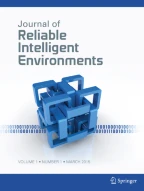Avoid common mistakes on your manuscript.
This Special Issue on Dependable and Secure Infrastructures and Systems in Intelligent Environments is in the intersection of the topics of the 18th edition of the European Dependable Computing Conference (EDCC 2022) and the interest of the Journal of Reliable Intelligent Environments. In particular, the SI is focused on dependability and security of sensing systems. The basic idea is to build secure and dependable systems by enriching the environment with technology, e.g., sensors, processors, actuators, information terminals, and other devices interconnected through a network. Moreover, based on the real-time information gathered and the historical data accumulated, decisions can be taken to benefit the users of that environment. Sensing systems are, for example, heavily employed in critical infrastructures, where their safe and reliable operation is crucial to maintaining essential services that our modern society relies on.
The articles included in this SI make important contributions to further improve the resilience of sensing systems, helping engineers to address pressing issues that affect the cybersecurity and dependability of these systems. The following papers are included in this SI:
An extension of the ADVISE meta-modeling framework and its application for an early stage security analysis of a public transport supervision system—by F. Mariotti, A. Bondavalli, P. Lollini, L. Montecchi, and S. Nardi—This paper presents improvements of the ontology of the ADversary VIew Security Evaluation (ADVISE) Meta framework, which is used for meta-level security modeling. The authors extend ADVISE Meta with profiles from the Threat Agent Library (TAL) and representative attack patterns from the Common Attack Pattern Enumeration and Classification (CAPEC) database. The provided extension facilitates the analysis of a system’s security level, which was demonstrated through a case study from the transportation domain.
DeepSHARQ: hybrid error coding using deep learning—by P. Gil Pereira, K. Vogelgesang, M. Miodek, A. Schmidt, and T. Herfet—This paper focuses on error control for resource-constrained devices that are commonly integrated in networked cyber-physical systems. The approach first decomposes the hybrid error-coding configuration search. Based on this, it introduces a search algorithm named DeepSHARQ that combines algorithmic and learning-based approaches to obtain optimal hybrid error-coding configurations in real time. Owing to its hybrid nature, DeepSHARQ outperforms previous solutions in terms of the response speed to channel changes.
Toward AI-assisted digital twins for smart railways: preliminary guideline and reference architecture —by L. De Donato, R. Dirnfeld, A. Somma, A. De Benedictis, F. Flammini, S. Marrone, M. Saman Azari, and V. Vittorini—This paper surveys the adoption of digital twins (DT) in the railway domain and the role played by Artificial Intelligence (AI) technologies in the development of smart decision-making software solutions. From this study, it emerges that predictive maintenance is one of the most promising services that can take advantage from the combination of DT and AI. Therefore, the paper proposes a development workflow and a high-level architecture for AI-enabled DTs supporting predictive maintenance in the railway sector.
Evaluation of IoT-based remote monitoring systems for stand-alone solar PV installations in Kenya —by F. Njoka, L. Thimo, and A. Agarwal—This paper investigates the characteristics of the modern Internet-of-Things (IoT) platforms employed in the remote monitoring of off-grid solar photovoltaic (PV) systems and evaluates the benefit, in terms of cost savings, of employing them for operations and remote maintenance. The cost-saving analysis is based on three PV systems remotely monitored and it is carried out by classifying the system faults according to their criticality, with the aim of filtering those that require an on-site intervention from the technicians. Results from the analysis show the effective benefits of remote maintenance that can reduce costs up to 95% compared to locally monitored systems.
mLBOA-DML: modified butterfly optimized deep metric learning for enhancing accuracy in intrusion detection system—by V. Prabhakaran and A. Kulandasamy—This paper proposes a novel deep metric learning algorithm to detect both network and host-based attacks in cloud computing environments. The performance of the detector has been assessed using two open datasets, and the experimental comparative results show that the detector outperforms the performance of previous proposals.
Secure data sharing with blockchain for remote health monitoring applications: a review—by V. Upadrista, S. Nazir, and H. Tianfield—This paper revises the use of blockchain technology in remote health monitoring applications which is aimed at addressing the challenges of security, integrity, latency, and reliability. The study reveals that private blockchains, compared to public ones, offer better solutions to data security and privacy concerns; however, they still have single-point-of-failure limitations.
Acknowledgements
The guest editors would like to thank all the authors and the reviewers for their work, the Editors-in-Chief—Prof. Juan Carlos Augusto and Prof. Antonio Coronato—and Editorial staff for their support during the overall process.
Author information
Authors and Affiliations
Corresponding author
Additional information
Publisher's Note
Springer Nature remains neutral with regard to jurisdictional claims in published maps and institutional affiliations.
Rights and permissions
About this article
Cite this article
Bernardi, S., Eckhart, M., Merseguer, J. et al. Dependable and secure infrastructures and systems in intelligent environments. J Reliable Intell Environ 9, 261–262 (2023). https://doi.org/10.1007/s40860-023-00211-x
Published:
Issue Date:
DOI: https://doi.org/10.1007/s40860-023-00211-x
